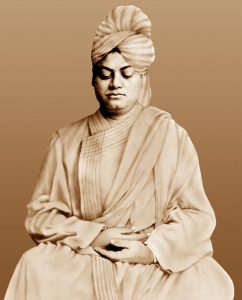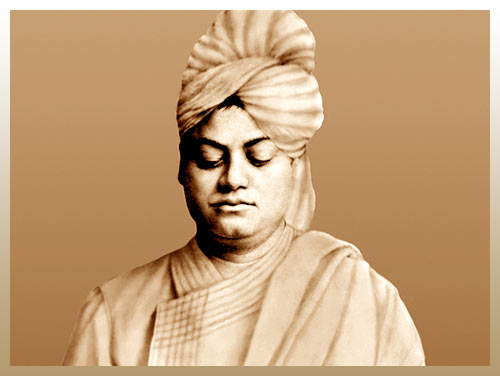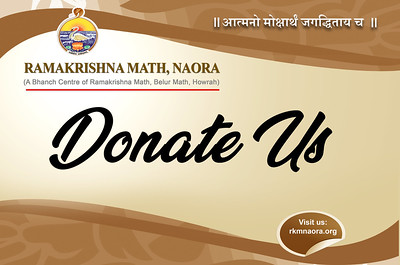Swami Vivekananda, known in his pre-monastic life as Narendra Nath Datta, was born into an affluent family in Kolkata on 12 January 1863.
 His father was Vishwanath Datta, a well-known Kolkata attorney, and his mother, Bhuvaneshwari Devi, was endowed with deep devotion, strong character and other noble qualities. A precocious boy, Narendra excelled in music, gymnastics and academic studies. By the time he graduated from Calcutta University, he had acquired a vast knowledge of different subjects, especially Western philosophy and history. Born with a yogic temperament, he used to practice meditation even from his boyhood, and was associated with the Brahmo Samaj reform movement for some time.
His father was Vishwanath Datta, a well-known Kolkata attorney, and his mother, Bhuvaneshwari Devi, was endowed with deep devotion, strong character and other noble qualities. A precocious boy, Narendra excelled in music, gymnastics and academic studies. By the time he graduated from Calcutta University, he had acquired a vast knowledge of different subjects, especially Western philosophy and history. Born with a yogic temperament, he used to practice meditation even from his boyhood, and was associated with the Brahmo Samaj reform movement for some time.
However, his philosophical mind was restless, and the Brahmo Samaj could not satisfy his quest for the true meaning of life. Encouraged by one of his relatives, Naren met the Bengali saint Sri Ramakrishna in November 1881. This incident affected Naren a great deal, and he gradually came to realise that Ramakrishna was an extraordinary man. Spending quality time with the saint, Naren gradually began to look upon him as his guide. He eventually accepted Sri Ramakrishna as his master and became completely dedicated to him.
A group of chosen young men had gathered around Sri Ramakrishna and had begun to receive spiritual guidance from him. When he developed throat cancer, they undertook to nurse him. Naren was the leader of this group. Ramakrishna had wanted them to take to monastic life and had symbolically given them saffron clothes. Keeping in line with their master’s wish, the group founded a monastery at Baranagar and began to live together. They supported themselves by begging, without knowing where this journey would take them. It was during this time that Naren took for himself the name Vivekananda (meaning “the bliss of discernment”), in keeping with the monastic traditions of India.
After the Master’s passing away, Vivekananda set out on a long, extensive pilgrimage throughout India, and came to realise the abject poverty, illiteracy and degradation of the Indians at large. Later, in 1888, Vivekananda left the monastery as a parivrajaka-a wandering monk, “without fixed abode, without ties, independent, and a stranger wherever he goes.” His sole possessions were a kamandalu (water pot), staff, and his two favorite books-The Bhagavad Gita and The Imitation of Christ. Vivekananda travelled the length and breadth of India for five years, visiting important centres of learning, acquainting himself with the diverse religious traditions and different patterns of social life. He developed a sympathy for the suffering and poverty of the masses and resolved to uplift the nation. Living mainly on bhiksha (alms), Vivekananda travelled mostly on foot and by railway, using tickets bought by admirers whom he met on the way. During these travels he met and stayed with scholars, dewans, rajas and people from all walks of life-Hindus, Muslims, Christians, Pariahs (low-caste workers) and government officials.
He approached many Indian princes of the time to see if they could do anything for the common people of India. Gradually this idea spread amongst the leaders, and a slow change began to take place. The ruler of Mysore was among the first to make primary education free within his state. This, however, was not enough in Swamiji’s view. He wanted education taken to the peasant’s doorstep, so that the peasant’s children could work and learn at the same time. His correspondence with the Maharaja of Mysore on the subject reveal how genuine and palpable his ideas were. Vivekananda reached Kanyakumari, the southernmost tip of the Indian subcontinent, on 24 December 1892. He swam through the sea and started meditating on a lone rock for three days on the past, present and future of India. The rock is today a primary tourist destination and is called the Vivekananda Rock Memorial.
Vivekananda attended the 1893 World’s Parliament of Religions in Chicago, Illinois, and earned great applause for beginning his address with the famous words, “Sisters and brothers of America.” It was Vivekananda’s arrival in the USA that started the beginning of Western interest in Hinduism-not as merely an exotic Eastern oddity, but as a vital religious and philosophical tradition. A few years after the Parliament, Vivekananda started Vedanta centres in New York City and London, and lectured at major universities on Hinduism.
From the West, he also set his Indian work in motion. Vivekananda wrote a stream of letters to India, giving advice and sending money to his followers and brother monks. His letters from the West in those days laid down the motive of his campaign for social service. He constantly tried to inspire his close disciples in India to do something big. His letters to them contain some of his strongest words. In one such letter, he wrote to Swami Akhandananda,
Eventually, in 1895, the periodical called The Brahmavadin was started in Madras, with money supplied by Vivekananda, for the purpose of teaching Vedanta.
After spreading India’s ancient wisdom in the USA and England for four years, he returned to India in 1897. Soon after his arrival, he inaugurated the Ramakrishna Mission, a unique organization in which monks of the Ramakrishna Order work together with lay devotees for the uplift of the poor masses through social service programmes, being inspired by the ideal that Sri Ramakrishna gave to Swami Vivekananda
He founded two other monasteries-one at Mayavati, near Almora in the Himalayas, called Advaita Ashrama; and another at Madras. Two journals were also started: Prabuddha Bharata in English and Udbodhan in Bengali. The same year, famine relief work was started by Swami Akhandananda in Murshidabad district.
His tours, hectic lecturing schedule, private discussions and correspondence, not to mention the privations he had endured during his early years of wandering, had taken their toll on his health. He was suffering from asthma, diabetes and other physical ailments. A few days before he died, he was seen intently studying the almanac. Three days before his death he pointed out the spot for his cremation, where a temple in his memory stands today.
Vivekananda died at ten minutes past nine p.m. on July 4, 1902, while he was meditating, fulfilling his own prophecy that he would not live to be forty.
Swami Vivekananda believed that the essence of Hinduism was best expressed in the Vedanta philosophy, based on the interpretation of Adi Shankara. He summarized the Vedanta’s teachings as follows:
- Each soul is potentially divine.
- The goal is to manifest this Divinity within by controlling nature, external and internal.
- Do this either by work, or worship, or mental discipline, or philosophy-by one, or more, or all of these-and be free.
- This is the whole of religion. Doctrines, or dogmas, or rituals, or books, or temples, or forms, are but secondary details.
He founded two other monasteries-one at Mayavati, near Almora in the Himalayas, called Advaita Ashrama; and another at Madras. Two journals were also started: Prabuddha Bharata in English and Udbodhan in Bengali. The same year, famine relief work was started by Swami Akhandananda in Murshidabad district.
His tours, hectic lecturing schedule, private discussions and correspondence, not to mention the privations he had endured during his early years of wandering, had taken their toll on his health. He was suffering from asthma, diabetes and other physical ailments. A few days before he died, he was seen intently studying the almanac. Three days before his death he pointed out the spot for his cremation, where a temple in his memory stands today.
Vivekananda died at ten minutes past nine p.m. on July 4, 1902, while he was meditating, fulfilling his own prophecy that he would not live to be forty.
Swami Vivekananda believed that the essence of Hinduism was best expressed in the Vedanta philosophy, based on the interpretation of Adi Shankara. He summarized the Vedanta’s teachings as follows:

